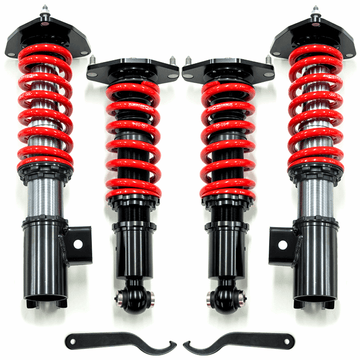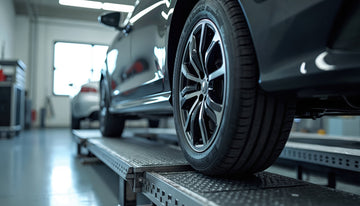Bump stops are mechanical components designed to prevent excessive suspension travel and provide additional damping during high-impact situations in automotive vehicles. Bump stops serve as secondary suspension buffers, typically made of rubber, foam, or in the case of hydraulic bump stops, a combination of oil and gas-filled chambers.
Bump stops are strategically positioned in the suspension system to limit the upward or downward movement of the suspension components, such as the suspension arms or shock absorbers, when the vehicle encounters bumps, potholes, or other uneven road surfaces. These components act as "cushions" that absorb energy and prevent the suspension from bottoming out or overextending, which could lead to damage to the suspension components or chassis.
Types of Bump Stops: Which One is Right for Your Vehicle?
There are several types of bump stops used in automotive applications, each designed to serve specific purposes and accommodate different suspension systems and vehicle requirements. Common types of bump stops include;
Rubber bump stops
Rubber bump stops are the most common and widely used type. They are typically made of durable rubber or elastomer materials. Rubber bump stops provide a cushioning effect during suspension compression, limiting the travel of the suspension components and preventing metal-to-metal contact. They are cost-effective, easy to install, and suitable for various vehicle applications.
Hydraulic bump stops
Hydraulic bump stops, as mentioned in the previous answer, are a specialised type of bump stop that incorporates a hydraulic chamber filled with oil and gas. They provide a progressive and adjustable damping effect during suspension compression, offering superior control and impact absorption. Hydraulic bump stops are commonly used in off-road vehicles, racing applications, and heavy-duty trucks to handle extreme off-road conditions and high-speed impacts.
Air bump stops
Air bump stops, also known as pneumatic bump stops, utilise air pressure to provide damping and control suspension travel. They consist of an air chamber and a piston mechanism that regulates the compression and rebound forces. Air bump stops are adjustable and offer precise tuning capabilities, making them popular in off-road and racing applications where suspension fine-tuning is essential.
Maintenance and Replacement: Keeping Your Bump Stops in Top Condition
Maintaining bump stops is relatively straightforward and can help ensure their effectiveness and longevity. Here are some tips for maintaining your bump stops:
Visual inspection
Regularly inspect your bump stops for signs of wear, damage, or deterioration. Look for any cracks, tears, or deformities in rubber or foam bump stops. For hydraulic or air bump stops, check for any leaks, damaged seals, or compromised components. If you notice any issues, consider replacing the bump stops.
Cleanliness
Keep your bump stops clean from dirt, mud, and other contaminants. Use a mild soap and water solution or a suitable automotive cleaner to clean the bump stops. Avoid using harsh chemicals or solvents that could damage the bump stop material. Gently scrub and rinse them, and allow them to dry thoroughly before reinstalling.
Lubrication
If your bump stops feature movable components such as hydraulic pistons or air chambers, lubricate them as per the manufacturer's recommendations. Use a suitable lubricant to ensure smooth operation and prevent friction-related issues. Refer to the product manual or consult with a professional if you are unsure about the lubrication requirements.
Regular suspension maintenance
Properly maintaining your suspension system is indirectly beneficial to the bump stops. Ensure that your shocks or struts are in good condition and functioning correctly. Replace worn-out or damaged suspension components promptly, as excessive wear or malfunctioning parts can put additional stress on the bump stops.
Driving habits
Be mindful of your driving habits, particularly when encountering large bumps, potholes, or off-road terrain. Avoid excessive speeds over rough surfaces to minimise the impact on the bump stops and suspension components. Smooth driving and careful navigation of obstacles can help prolong the life of the bump stops.
Consult the manufacturer
If you have any specific questions or concerns regarding the maintenance of your vehicle's bump stops, it's always a good idea to consult the manufacturer's recommendations or contact a trusted dealership or mechanic. They can provide you with accurate information tailored to your vehicle's make and model.
Common Issues: Troubleshooting Problems with Your Bump Stops
Bump stops are really important in suspension systems because they prevent your vehicle from compressing too much and hitting the ground. But sometimes they can have problems that affect how well they work. It's really important to understand and fix these issues so that your suspension system stays in good shape and keeps working efficiently.
One common issue with bump stops is their deterioration or damage over time. Exposure to harsh road conditions, extreme temperatures, and general wear and tear can lead to degradation. Inspecting and replacing worn-out or damaged bump stops is necessary to ensure their effectiveness.
Another problem is selecting bump stops that are either too firm or too soft for your specific vehicle and driving style. If the bump stops are too firm, they may transmit excessive impact and vibrations to the suspension, compromising ride quality. On the other hand, if the bump stops are too soft, they may easily bottom out, causing discomfort and potentially damaging the suspension components. It's crucial to choose the right firmness based on your vehicle's specifications and intended use.
Proper installation is also vital for bump stop performance. If you don't position or secure your bump stops correctly, they won't provide the cushioning they're meant to, and they won't prevent excessive compression. To make sure they're installed properly, just follow the instructions from the manufacturer and reach out for professional help if you need it.
To keep your bump stops working well, address common issues like wear, firmness, and installation. Regular inspections, timely replacements, and choosing the right firmness will ensure a comfortable ride and protect your vehicle from damage.





